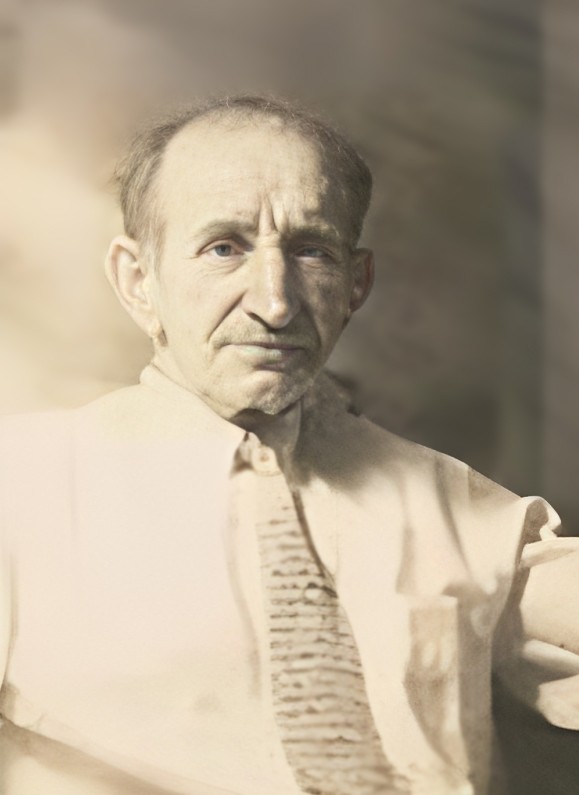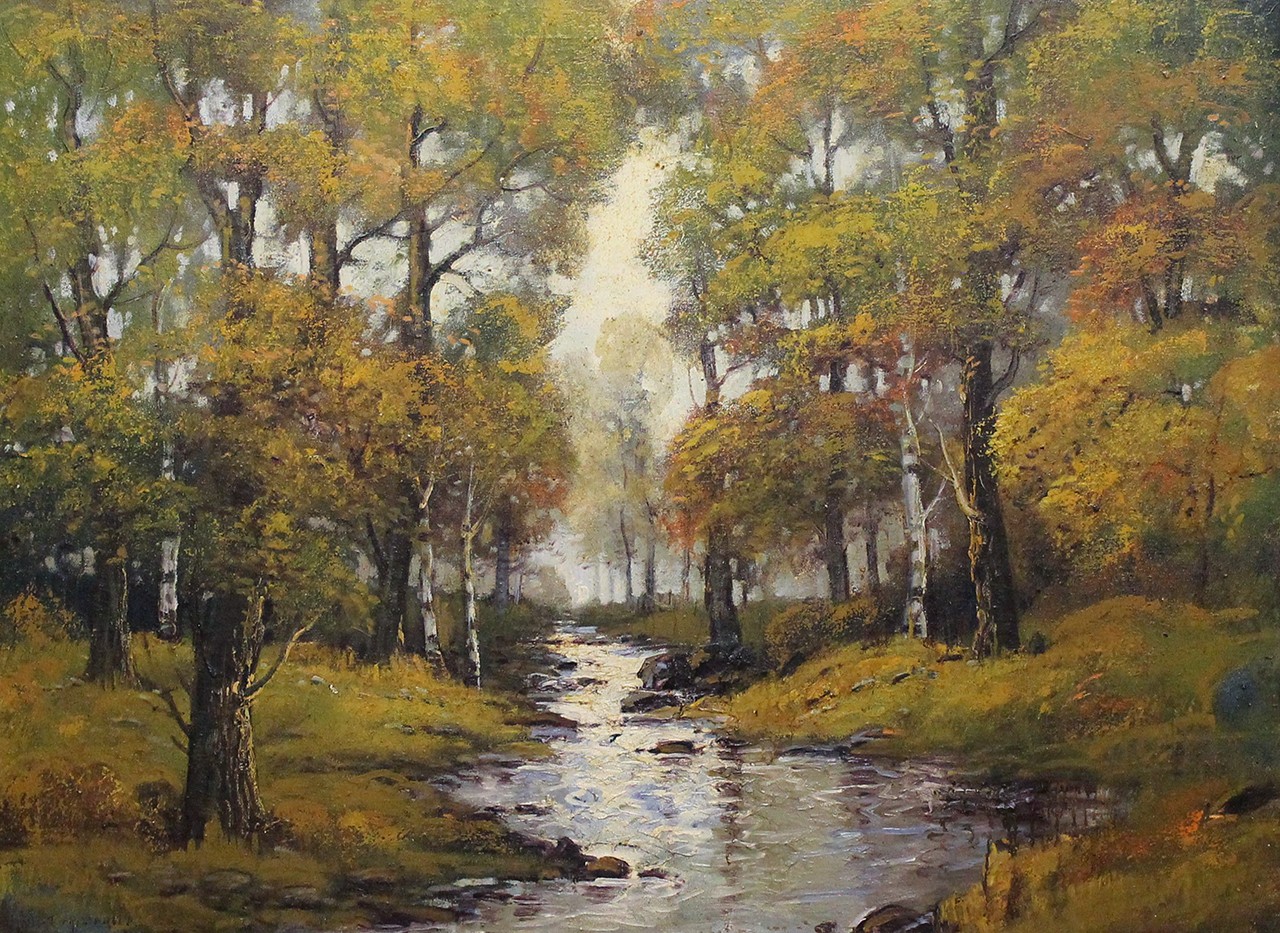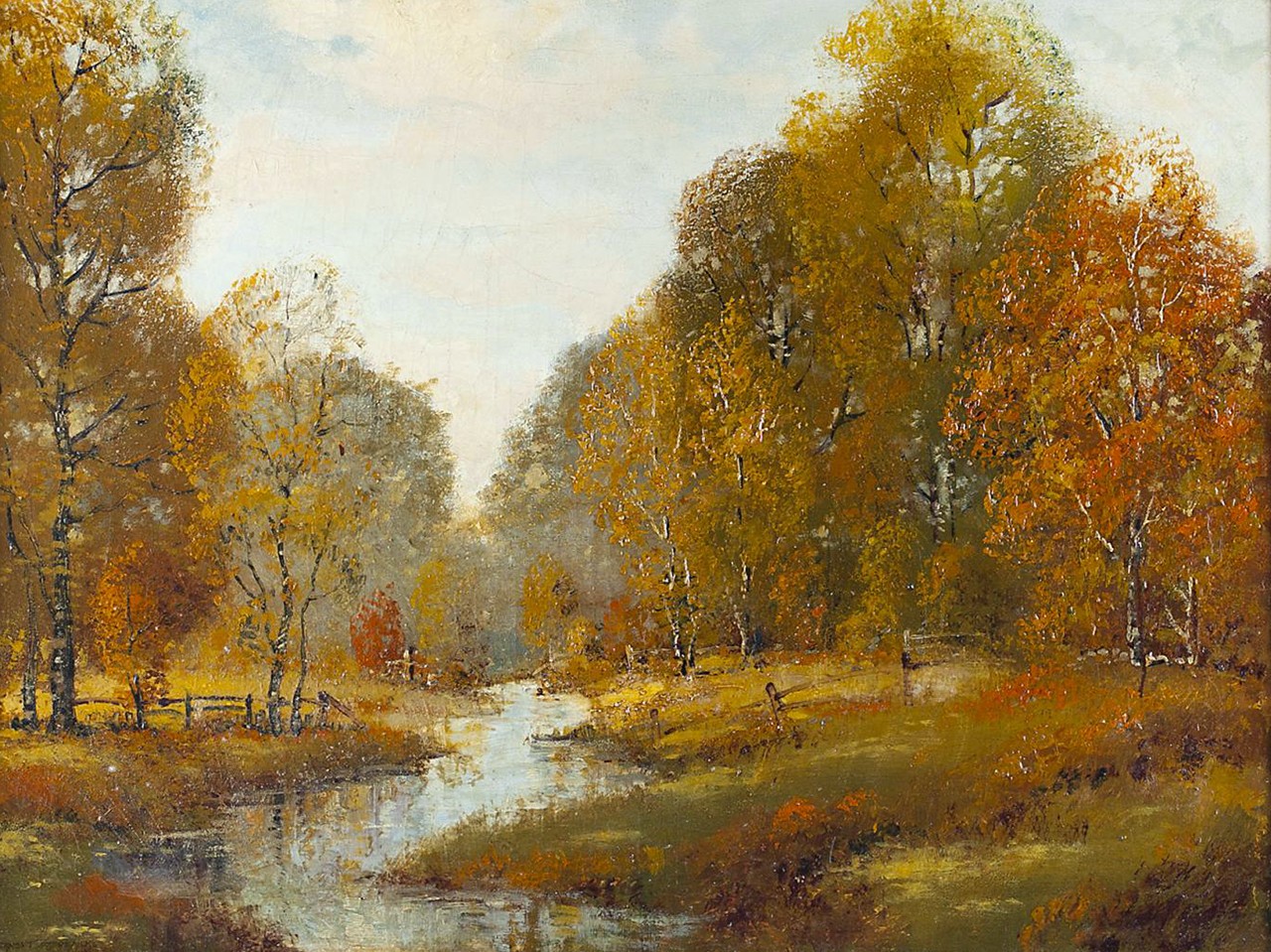 |
Detail of Autumnal Landscape, c. 1940
Ernest T. Fredericks (American, 1877-1959)
Oil on canvas; 30 x 38 in.
19963
Gift of Miss Sarah Jane Brittenham Estate |
Heartland Painter
Although we are deep into the autumn months, area trees would be looking about as green as ever had they not been so thoroughly denuded by our recent Santa Anas. But in locales north and east of where we are in bright California, leaves have, by this point, mostly donned their gold and red uniform. This post rounds out the Bowers Blog’s series on painters of the fall season by focusing on Ernest T. Fredericks’ Autumnal Landscape. Whereas both of the artists already featured in this series—Dwight W. Tryon and J. Francis Murphy—were East Coast painters who had trained at European academies, Ernest Fredericks came from a vastly different background, and his career took a substantially different trajectory.
 |
| Ernest T. Fredericks, c. 1950; enhanced with AI |
How Swede It Is
Though known throughout most of his career by the pseudonym Ernest Fredericks, the artist’s birth name, Frederick Ernest Swedlun, speaks to his Swedish ancestry. He was born in McPherson, Kansas in 1877 to Olof Swedlun and Christine M. Sandahl, and raised on a farm. There is some indication that he either trained with, knew, or was otherwise influenced by Birger Sandzen, a post-impressionist Swedish artist who taught at Bethany College in Lindsborg, Kansas. How exactly Fredericks gravitated towards painting can only be guessed at, though he was evidently interested in nature and the outdoors at an early age. Also well-established is that farm life did not agree with Fredericks’ sensibilities; as soon as he could, he made his way to Chicago to make a career in fine art. It was there that, likely hoping to avoid discrimination against Swedish immigrants, that he first started going by Ernest T. Fredericks.
 |
19963
Gift of Miss Sarah Jane Brittenham Estate |
An Equally Windy City
In Chicago, Fredericks studied at the Chicago Academy of Fine Art, exhibiting at the Art Institute of Chicago, shows organized by the All-Illinois Society of the Fine Arts, and elsewhere. Though the years between 1900—when he married his wife, Cordella Florence Cayle—and 1950 constitute a significant portion of his life, not much is known about Fredericks’ work during this period. Based on the great array of auction records for his works, it appears that Fredericks did almost all of his painting in nature, making trips around the States, especially to the Ozarks, which seemed to capture a special piece of his heart.
 |
Ernest T. Fredericks (American, 1877-1959), Fall Trees
Image from Leland Little |
At the Bows
As seems to be the case with a great many artists, once Fredericks had found his Eden, his life was measured in minutes until his return there. He spoke of the Ozarks glowingly as an “artist’s gold mine of color and composition.” In 1950, he moved his family there, to Eureka Springs, and began working with his son, Glenn, to teach art classes in the area. As a function of how the times had changed or of the new locale, he returned to signing artworks with his birth name. A great many of his paintings of autumn are of the Ozarks and featured brilliant gold and yellow hues. Fredericks’ spent his golden years there, passing away in 1959.
 |
Detail of 19963
Gift of Miss Sarah Jane Brittenham Estate |
Stream of Autumn
Continuing in the theme of aspects of Fredericks’ life and work being something of a question mark, there is almost no information available on the Bowers’ Fredericks aside from what we can learn from a visual study. He tended not to date his paintings, but his signature tells us at the very least that the artwork was made before his 1950 move when he started signing his works differently. Compared against the works of the other artists in this series, this is by far the most pictorial, perhaps indicating some influence by the post-impressionist regionalist movements of the 1930s and ‘40s. Fredericks layers thick layers of paint to create a highly textured canvas. At the fore, layers of opaque paint are applied through dabbing rather than brushstrokes. In the background, a gray autumn sky cuts through gaps in the forest and blends in with hazily exacted trees. A central stream bridges these two disparate areas, a feature seen in other late-year landscapes by Fredricks.
Text and images may be under copyright. Please contact Collection Department for permission to use. References are available on request. Information subject to change upon further research.






Comments